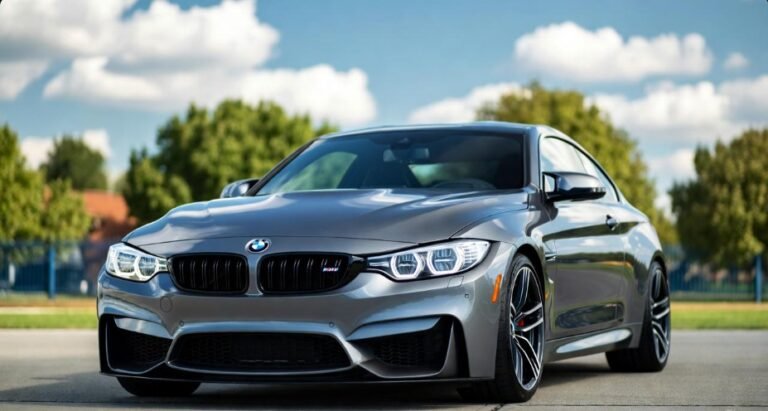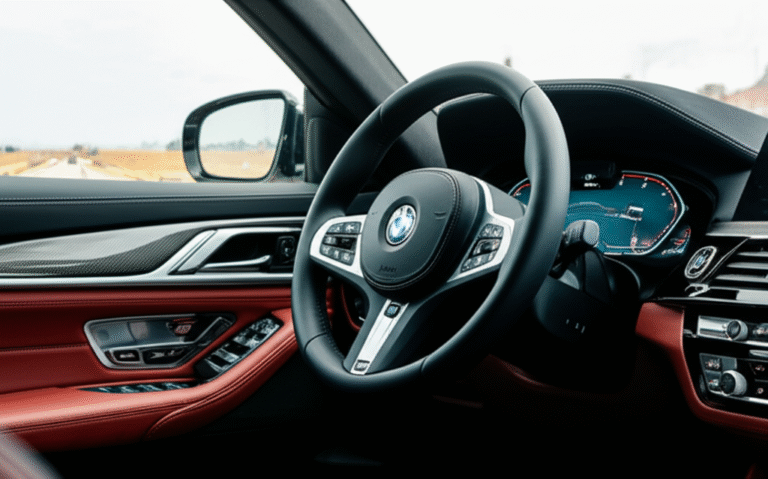How to Draw a BMW M5: 6 Simple Steps
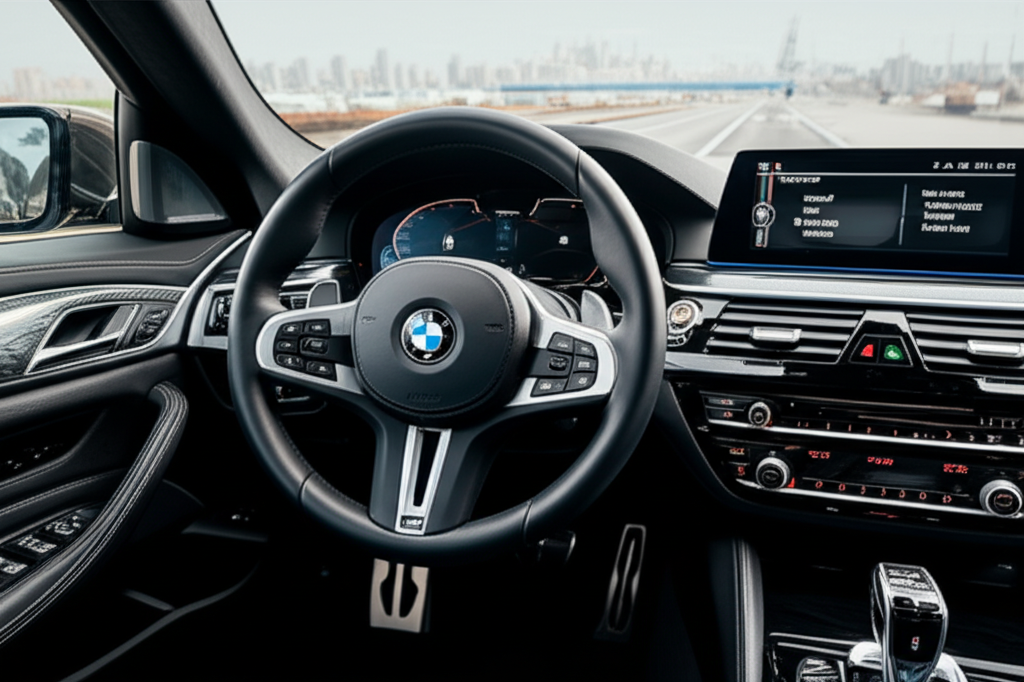
Learn how to draw a BMW M5 in 6 simple steps for beginners, transforming your artistic vision into a stunning automotive masterpiece.
Key Takeaways
- Sketch the basic outline of the M5’s silhouette.
- Add foundational body lines and wheel placements.
- Refine the iconic grille and headlight details.
- Draw the distinctive M5 aerodynamic features.
- Add realistic wheel designs and window reflections.
- Shade and detail to bring your BMW M5 drawing to life.
Dreaming of sketching the powerful BMW M5? You might think capturing the aggressive lines and luxurious details of this performance sedan is a challenge. Many aspiring artists find themselves intimidated by such iconic machinery. But there’s no need to worry! With a clear, step-by-step approach, anyone can learn how to draw a BMW M5. We’ll guide you through each stage, from the initial shapes to the final, polished details. Get ready to unleash your inner artist and create an impressive drawing of this legendary car. Let’s get started on this exciting artistic journey!
Understanding the BMW M5: More Than Just a Car
Before we put pencil to paper, it’s helpful to understand what makes the BMW M5 so special. The M5 is the high-performance variant of BMW’s 5 Series executive sedan. It’s renowned for blending luxury with exhilarating speed and handling, often described as a “super sedan.” Its design is characterized by muscular lines, aggressive aerodynamic enhancements, and distinctive M-specific styling cues. Key identifying features include the signature kidney grille (often larger and more pronounced on M models), sharp LED headlights, sculpted M mirrors, quad exhaust pipes, and prominent M wheels. Understanding these elements will help you capture its essence in your drawing.
Gathering Your Drawing Essentials
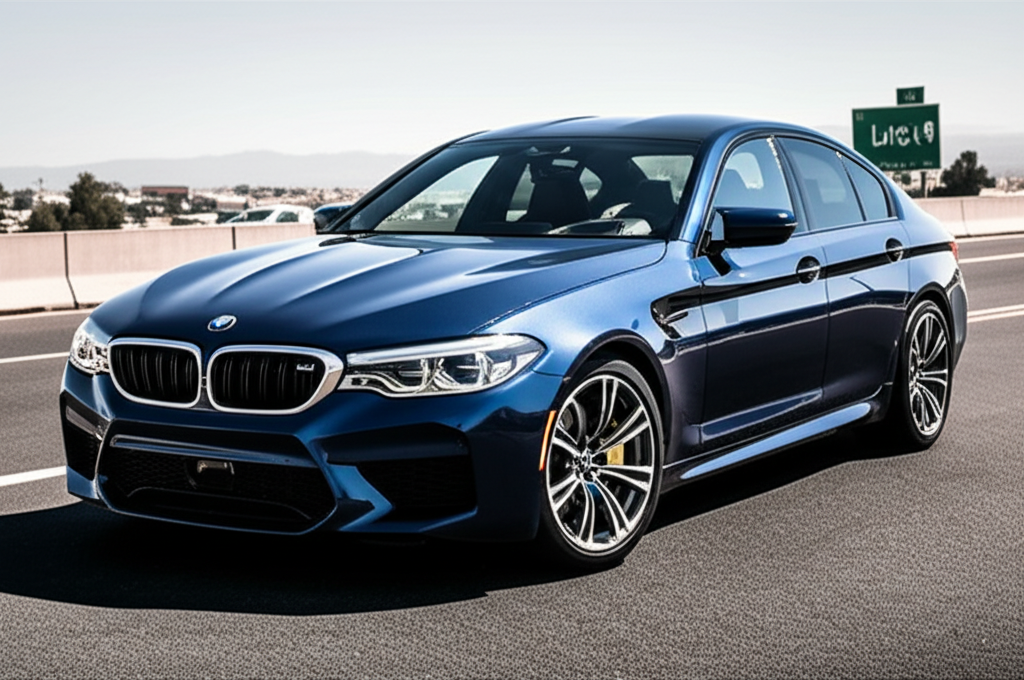
To begin your journey on how to draw a BMW M5, you’ll need a few basic supplies. Fortunately, you don’t need anything overly specialized. Having the right tools can make the process smoother and more enjoyable. Here’s what we recommend:
Essential Tools for Your Drawing Project
- Pencils: A variety of graphite pencils (e.g., HB for sketching, 2B for darker lines, 4B or 6B for shading) will be very useful.
- Paper: Smooth drawing paper or good quality printer paper is ideal.
- Eraser: A kneaded eraser is great for lifting graphite, and a standard eraser is useful for clean corrections.
- Sharpener: Keep your pencils sharp for precise lines.
- Reference Image: A clear, high-resolution photo of the BMW M5 from the angle you wish to draw will be your best friend.
How to Draw a BMW M5: 6 Simple Steps for Beginners
Now, let’s dive into the step-by-step process of drawing your very own BMW M5. We’ll break it down into manageable stages, perfect for beginners. Remember to work lightly at first so you can easily make adjustments.
Step 1: Sketching the Basic Silhouette and Proportions
Every great drawing starts with a solid foundation. For our BMW M5, we’ll begin by lightly sketching the overall shape of the car. Think about the car’s profile. Is it a ¾ view, a side profile, or a front view? For a dynamic pose, a ¾ view is often best. Start with basic geometric shapes. A large rectangle can represent the main body of the car. Inside this, sketch a slightly smaller rectangle for the cabin. Connect these shapes with flowing lines, paying attention to the car’s distinctive slope from the roof to the trunk, and the lower body lines that give it a grounded, aggressive stance. Don’t worry about perfection at this stage; we’re just establishing the basic form and proportions. Use your reference image constantly to guide these initial lines.
Imagine you are drawing a sleek, aerodynamic wedge. The front of the car will typically be lower than the rear, creating a sense of motion even when static. The roofline should curve smoothly into the rear window, and the trunk should have a slightly upturned spoiler lip, a common feature on performance sedans like the M5. Pay close attention to the length of the wheelbase (the distance between the front and rear wheels) and the overhangs (the parts of the car extending beyond the wheels). Getting these proportions right is crucial for a realistic drawing.
Step 2: Adding Foundational Body Lines and Wheel Placement
With the basic shape established, it’s time to refine it by adding key body lines. BMW designs are known for their precision and sharp creases. Look at your reference and identify the main character lines that run along the sides of the car. These lines often start from the front fender and sweep back towards the rear. They define the musculature and athleticism of the M5. Draw the lines for the doors, the hood, and the trunk. Then, carefully place the wheel wells. The wheels should be positioned correctly within these wells, ensuring they are large enough to fill the space appropriately, as performance cars often have larger wheels.
Wheel wells are not perfect circles; they usually have a slightly flattened top. The placement of the wheels is critical for realism. They need to be set back slightly from the very front and rear of the car’s body. If you’re drawing at a ¾ angle, the front wheel will appear slightly oval due to perspective, and the rear wheel will be more circular. Use your reference photo to get the exact placement and size. These lines are still light; we’re building up the drawing structure.
Step 3: Detailing the Iconic Grille and Headlights
The front of the BMW M5 is instantly recognizable due to its distinctive kidney grille and aggressive headlights. These are key elements that define the M5’s identity. The kidney grille is usually split into two distinct sections. Draw the contours of these grilles, paying attention to the vertical slats that are often a signature of BMW. Below the grille, sketch the lower air intakes, which are typically larger and more angular on M models to feed more air to the engine and brakes. Next, focus on the headlights. BMW headlights are known for their sharp, “angel eye” LED daytime running lights (DRLs) and intricate internal detailing. Draw the overall shape of the headlight housing and then add the internal elements, suggesting the complex lighting structure within. These details add a significant amount of character to your drawing.
The exact design of the grille and headlights can vary slightly between M5 generations. For example, the F90 M5 has a more integrated grille that flows into the hood, while older generations might have a more pronounced gap. Always refer to your specific reference image. Adding these elements with precision brings the front of your BMW M5 to life and makes it unmistakably identifiable as a premium performance vehicle.
Step 4: Drawing the Distinctive M5 Aerodynamic Features
The “M” in BMW M5 signifies motorsport heritage, and this is evident in its aerodynamic enhancements. These features are not just for show; they improve handling and stability at high speeds. Look for the M-specific side mirrors, which are often more sculpted than standard mirrors. Draw the sharper, more aggressive front bumper with larger air dams. Along the sides, you might notice distinctive side skirts or “M” gills integrated into the front fenders, which help to vent air and reduce lift. At the rear, the M5 typically features a subtle trunk lid spoiler for improved downforce and a rear diffuser to manage airflow under the car. These elements contribute significantly to the M5’s purposeful and sporty look. Draw them boldly but accurately, using your reference as a guide.
The aggressive styling of the M5 is a signature of its performance pedigree. The way the bodywork channels air is a key part of its engineering. Even if you’re drawing a simpler version, capturing the essence of these aerodynamic lines will elevate your drawing. Think about how these features create visual flow and accentuate the car’s performance capabilities. For instance, the quad exhaust pipes are a classic M-car signature, usually arranged in pairs on either side of the rear diffuser. Don’t forget to include those!
Step 5: Detailing the Wheels and Window Reflections
Wheels are like the shoes of a car, and the M5 has some stylish ones. BMW M wheels are often multi-spoke or complex designs that emphasize their performance nature. Carefully sketch the spokes, paying attention to their thickness, angles, and how they connect to the center hub. Remember that due to perspective, the wheels on the far side of the car will appear smaller and more compressed. Add the BMW logo in the center if your reference allows. For the windows, don’t just draw them as black shapes. Observe your reference photo for reflections. Cars, especially luxury performance vehicles, have reflective windshields, side windows, and rear windows. These reflections can be made by leaving areas of the glass lighter or by adding subtle highlights with your eraser. This adds depth and realism, making the car look like it’s sitting in a real environment.
The detail in the wheels can make a significant difference. If you’re feeling adventurous, try to depict the brake calipers and rotors visible through the spokes, a common feature on performance vehicles like the M5. For windows, think about what might be reflected: the sky, trees, buildings. Even abstract shapes of light and dark can add a convincing illusion of glass. This is where your shading pencils will start to come into play.
Step 6: Shading, Refinements, and Bringing Your M5 to Life
This is where your BMW M5 drawing truly comes to life. Begin shading the car’s body. Use your HB and 2B pencils to create smooth transitions of light and shadow. Observe where the light hits the car and where shadows fall. The curves of the bodywork will create highlights and darker areas. Think about the car’s paint – is it metallic? This can be suggested with subtle, blended shading. Use your kneaded eraser to lift out highlights on the paintwork, the edges of panels, and shiny surfaces like the headlights and chrome trim. Darken areas corresponding to the grille, air intakes, window frames, and the darker parts of the wheels. Use your 4B or 6B pencil for the deepest shadows, such as the tire treads, the interior of the exhaust pipes, and deep recesses in the bodywork.
Don’t forget to shade the tires. They are not just black circles; they have texture and form. Add subtle curves to indicate the tire wall and tread patterns. The ground beneath the car can also be shaded to cast a shadow, grounding your drawing and making it feel more three-dimensional. Take your time, add details gradually, and step back from your drawing frequently to assess your progress. This final stage is about refining all the elements and adding the finishing touches that make your BMW M5 drawing look dynamic and realistic. If you’re interested in the technical aspects of BMW vehicles, the official BMW USA website offers a wealth of information on their models and engineering.
Pro Tips for Drawing Luxury Performance Cars
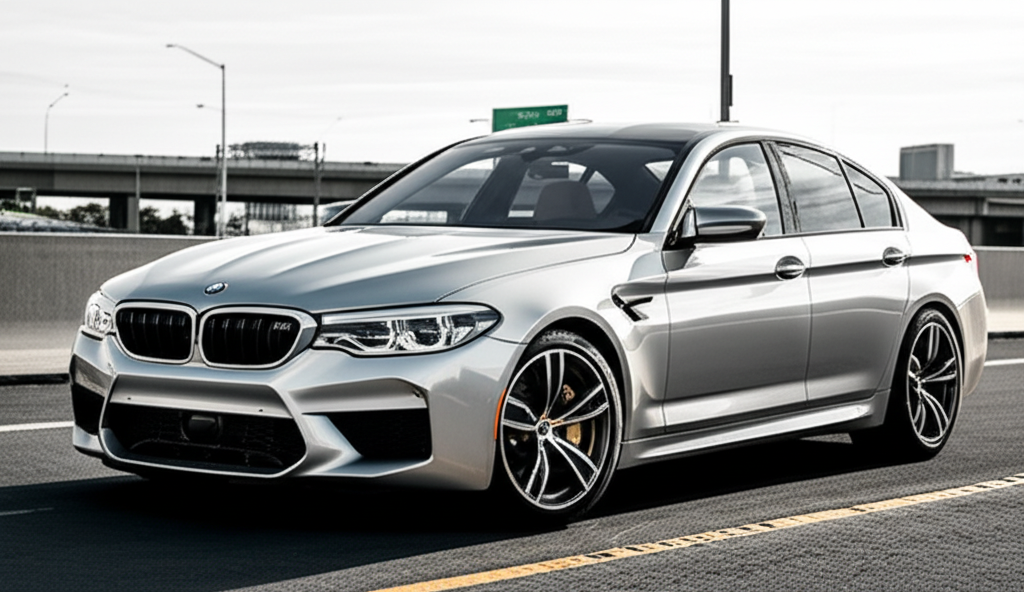
When drawing complex and high-performance vehicles like the BMW M5, remember these tips:
- Observe Edges: Luxury cars often have very sharp, clean edges. Pay attention to how light hits these edges to create sharp highlights.
- Reflections are Key: Shiny surfaces like paint and glass are crucial. Practice drawing smooth gradients and using your eraser to create realistic reflections.
- Break it Down: Don’t get overwhelmed. Focus on one section at a time – the front end, the side profile, the wheels.
- Vary Your Lines: Use different line weights. Thicker lines can define the overall shape, while thinner lines add detail and precision.
- Practice Makes Perfect: The more you draw, the better you’ll become. Don’t be afraid to experiment and make mistakes – that’s how you learn!
BMW M5 Drawing vs. Real Car: A Comparative Look
Drawing a BMW M5 involves translating a complex three-dimensional object into a two-dimensional representation. While a drawing can capture the essence and visual appeal of the car, there are inherent differences compared to the real vehicle. Here’s a simple comparison:
| Feature | Drawing | Real BMW M5 |
|---|---|---|
| Form & Volume | Created through lines, shading, and perspective. Can be stylized. | Tangible, physical material. Precise engineering and dimensions. |
| Surface Finish | Represented by texture of paper, pencil strokes, and shading. Can suggest metallic paint or gloss. | Actual metal, glass, and plastic with specific paint finishes, coatings, and textures. |
| Light Interaction | Simulated with highlights and shadows created by the artist. | Real-time interaction with ambient light, creating dynamic reflections and highlights. |
| Detail | Can be highly detailed or simplified, depending on skill and intent. | Engineered with intricate mechanical components, internal systems, and advanced technology. |
| Sensory Experience | Primarily visual. Evokes emotion through artistic interpretation. | Multi-sensory: sight, sound (engine roar), touch (steering wheel), smell (leather interior), performance feedback. |
Understanding these differences helps appreciate both the art of drawing and the engineering marvel that is the real BMW M5. The goal of your drawing is to capture the spirit and iconic design, not to replicate every single nut and bolt.
Frequently Asked Questions about Drawing the BMW M5
Q1: What is the best angle to draw a BMW M5 from?
A1: A ¾ view (slightly from the front or rear) is often the most dynamic and allows you to showcase key features like the grille, headlights, and profile lines effectively. However, the side profile or front view can also be excellent for emphasizing specific design elements.
Q2: How do I make the car look realistic and not flat?
A2: Use shading to create a sense of form and volume. Pay close attention to how light falls on the car’s curves and edges. Adding reflections in the windows and highlights on the paintwork will also significantly improve realism.
Q3: What kind of pencils should I use for shading?
A3: A range of graphite pencils is best. An HB for initial sketching, a 2B for mid-tones, and a 4B or 6B for deep shadows will give you a good range for creating contrast and depth.
Q4: How do I get the proportions of the car correct?
A4: Start with light, basic geometric shapes to establish the overall size and silhouette. Use your reference image constantly to compare the relationships between different parts of the car (e.g., wheel size to body length, roof height to wheelbase).
Q5: Can I draw a BMW M5 without a reference image?
A5: For beginners, it’s highly recommended to use a reference image. It provides accurate proportions, details, and lighting information. As you gain experience, you can start drawing from memory or imagination, but a reference is invaluable for learning.
Q6: How detailed should my drawing be?
A6: This depends on your skill level and patience. For beginners, focus on capturing the main shapes, key design lines, and prominent features like the grille and headlights. As you improve, you can add more intricate details like wheel spokes, interior elements (if visible), and subtle body creases.
Q7: What are some common mistakes beginners make when drawing cars?
A7: Common mistakes include incorrect proportions, flattened wheels, lack of shading/depth, ignoring reflections, and drawing too dark too soon, making corrections difficult. Starting light and building up detail is key.
Conclusion
You’ve now learned how to draw a BMW M5 in six simple steps! From laying down the initial silhouette to adding those final, crucial shading details, you’ve taken a journey through the process of capturing this iconic performance sedan on paper. Remember, practice is your greatest tool. Each drawing you create will build your confidence and skill. Keep referring to great reference images, experiment with different techniques, and most importantly, enjoy the process of bringing your passion for automobiles to life through art. The BMW M5 is a symbol of engineering excellence and driving pleasure, and now you can capture its spirit with your own artistic touch!

